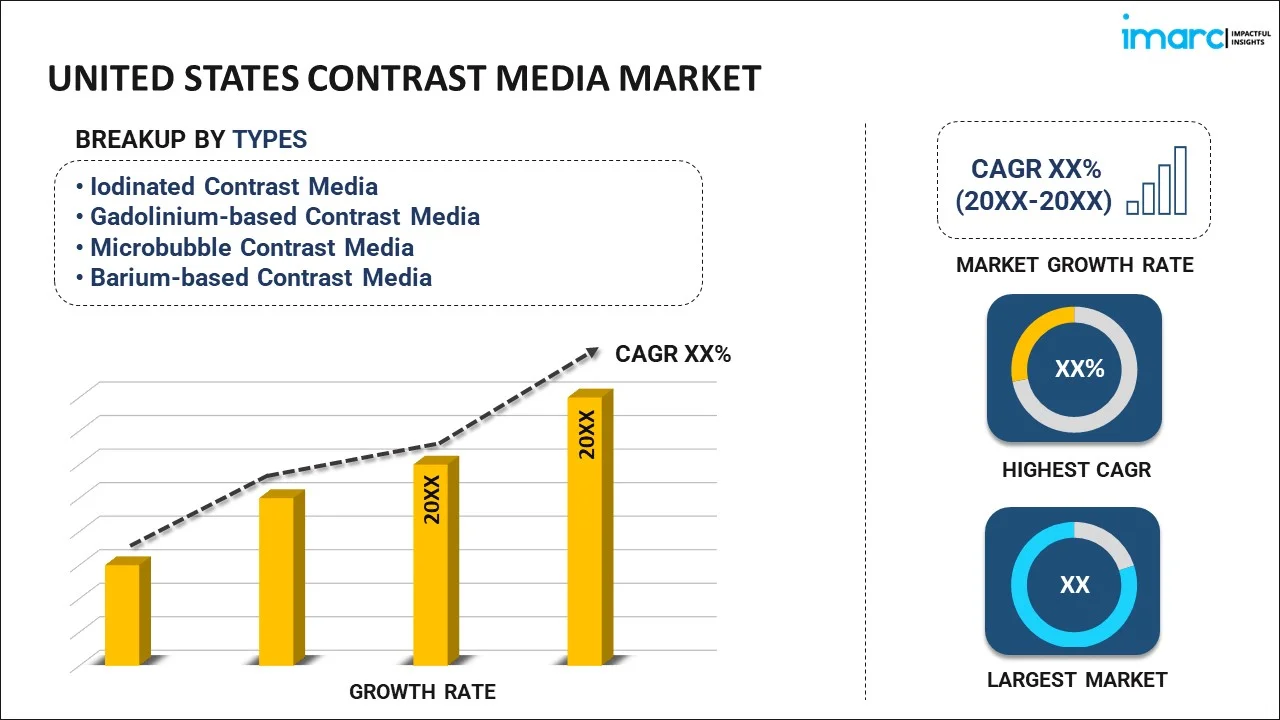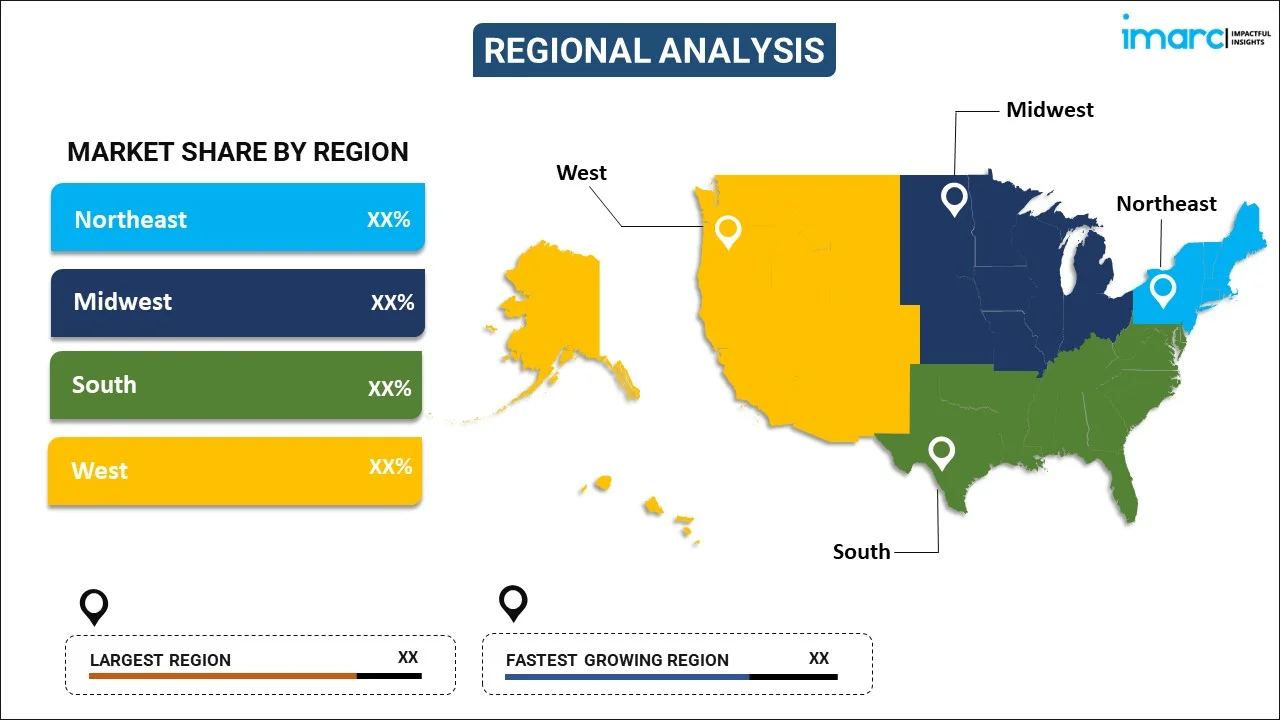
United States Contrast Media Market Report by Type (Iodinated Contrast Media, Gadolinium-based Contrast Media, Microbubble Contrast Media, Barium-based Contrast Media), Modality (X-ray/Computed Tomography (CT), Magnetic Resonance Imaging (MRI), Ultrasound), Application (Radiology, Interventional Radiology, Interventional Cardiology), Route of Administration (Intravenous/Intrarterial, Oral Route, Rectal Route, and Others), End User (Hospital, Clinics and Ambulatory Surgery Centers, Diagnostic Imaging Centers), and Region 2025-2033
Market Overview:
United States contrast media market size is projected to exhibit a growth rate (CAGR) of 3.9% during 2025-2033. The increasing prevalence of chronic diseases, aging population, emphasis on early detection, advancements in medical technology, collaborative research efforts, supportive regulatory environment, rising awareness, and expanding healthcare infrastructure represent some of the key factors driving the market.
|
Report Attribute
|
Key Statistics
|
|---|---|
|
Base Year
|
2024 |
|
Forecast Years
|
2025-2033 |
|
Historical Years
|
2019-2024
|
| Market Growth Rate (2025-2033) | 3.9% |
Contrast media, also known as contrast agents or contrast dyes, are substances used in medical imaging procedures to enhance the visibility of internal structures or fluids in the body. It is typically administered intravenously, orally, or directly into specific body cavities. This solution contains elements that alter the way X-rays, computed tomography (CT) scans, magnetic resonance imaging (MRI), or other imaging modalities interact with bodily tissues. Some of the standard contrast media used for X-ray-based imaging include iodine and barium, while gadolinium is employed in MRI contrast imaging. These substances highlight blood vessels, organs, or specific tissues, enabling healthcare professionals to obtain clearer and more detailed images for accurate diagnosis and treatment planning. The use of contrast media is particularly valuable in identifying abnormalities, such as tumors, vascular irregularities, or organ malfunctions, that may be otherwise challenging to discern on standard images. The judicious application of contrast media significantly improves the diagnostic efficacy of medical imaging, contributing to better patient outcomes in various clinical scenarios.
United States Contrast Media Market Trends:
The increasing prevalence of chronic diseases, such as cardiovascular disorders (CVD) and cancers, necessitating advanced diagnostic imaging for accurate disease characterization and treatment planning, is primarily driving the contrast media market in the United States. In confluence with this, the expanding geriatric population contributes to a higher incidence of age-related diseases, requiring more sophisticated imaging techniques that leverage contrast agents for improved diagnostic precision, thereby strengthening the market growth. Moreover, the growing emphasis on early disease detection and prevention has heightened the demand for contrast media as an essential tool for identifying subtle abnormalities and initiating timely interventions, creating a favorable outlook for market expansion. In line with this, the rise of minimally invasive (MI) procedures in the healthcare industry has heightened the reliance on contrast-enhanced imaging for guiding interventions, strengthening the market growth. Concurrently, ongoing advancements in medical technology, particularly in imaging equipment and contrast agent formulations, are presenting lucrative opportunities for market expansion. In addition to this, the rising adoption of multimodal imaging approaches, such as combining CT and MRI for comprehensive diagnostics, underscores the versatile utility of contrast media, thereby providing an impetus to the market growth. Furthermore, the increasing collaborative efforts between pharmaceutical companies and research institutions and extensive investments in research and development (R&D) activities to develop novel contrast agents and improve existing formulations are contributing to the market expansion. Apart from this, the escalating demand for outpatient imaging services, spurred by the need for convenient and timely diagnostics, is acting as another significant growth-inducing factor.
United States Contrast Media Market Segmentation:
IMARC Group provides an analysis of the key trends in each segment of the market, along with forecasts at the country level for 2025-2033. Our report has categorized the market based on type, modality, application, route of administration, and end user.
Type Insights:

- Iodinated Contrast Media
- Gadolinium-based Contrast Media
- Microbubble Contrast Media
- Barium-based Contrast Media
The report has provided a detailed breakup and analysis of the market based on the type. This includes iodinated contrast media, gadolinium-based contrast media, microbubble contrast media, and barium-based contrast media.
Modality Insights:
- X-ray/Computed Tomography (CT)
- Magnetic Resonance Imaging (MRI)
- Ultrasound
A detailed breakup and analysis of the market based on the modality have also been provided in the report. This includes x-ray/computed tomography (CT), magnetic resonance imaging (MRI), and ultrasound.
Application Insights:
- Radiology
- Interventional Radiology
- Interventional Cardiology
The report has provided a detailed breakup and analysis of the market based on the application. This includes radiology, interventional radiology, and interventional cardiology.
Route of Administration Insights:
- Intravenous/Intrarterial
- Oral Route
- Rectal Route
- Others
A detailed breakup and analysis of the market based on the route of administration have also been provided in the report. This includes intravenous/intrarterial, oral route, rectal route, and others.
End User Insights:
- Hospital, Clinics and Ambulatory Surgery Centers
- Diagnostic Imaging Centers
The report has provided a detailed breakup and analysis of the market based on the end user. This includes hospital, clinics and ambulatory surgery centers and diagnostic imaging centers.
Regional Insights:

- Northeast
- Midwest
- South
- West
The report has also provided a comprehensive analysis of all the major regional markets, which include Northeast, Midwest, South, and West.
Competitive Landscape:
The market research report has also provided a comprehensive analysis of the competitive landscape in the market. Competitive analysis such as market structure, key player positioning, top winning strategies, competitive dashboard, and company evaluation quadrant has been covered in the report. Also, detailed profiles of all major companies have been provided.
United States Contrast Media Market Report Coverage:
| Report Features | Details |
|---|---|
| Base Year of the Analysis | 2024 |
| Historical Period | 2019-2024 |
| Forecast Period | 2025-2033 |
| Units | Billion USD |
| Scope of the Report | Exploration of Historical Trends and Market Outlook, Industry Catalysts and Challenges, Segment-Wise Historical and Future Market Assessment:
|
| Types Covered | Iodinated Contrast Media, Gadolinium-based Contrast Media, Microbubble Contrast Media, Barium-based Contrast Media |
| Modalities Covered | X-ray/Computed Tomography (CT), Magnetic Resonance Imaging (MRI), Ultrasound |
| Applications Covered | Radiology, Interventional Radiology, Interventional Cardiology |
| Routes of Administration Covered | Intravenous/Intrarterial, Oral Route, Rectal Route, Others |
| End Users Covered | Hospital, Clinics and Ambulatory Surgery Centers, Diagnostic Imaging Centers |
| Regions Covered | Northeast, Midwest, South, West |
| Customization Scope | 10% Free Customization |
| Post-Sale Analyst Support | 10-12 Weeks |
| Delivery Format | PDF and Excel through Email (We can also provide the editable version of the report in PPT/Word format on special request) |
Key Questions Answered in This Report:
- How has the United States contrast media market performed so far and how will it perform in the coming years?
- What has been the impact of COVID-19 on the United States contrast media market?
- What is the breakup of the United States contrast media market on the basis of type?
- What is the breakup of the United States contrast media market on the basis of modality?
- What is the breakup of the United States contrast media market on the basis of application?
- What is the breakup of the United States contrast media market on the basis of route of administration?
- What is the breakup of the United States contrast media market on the basis of end user?
- What are the various stages in the value chain of the United States contrast media market?
- What are the key driving factors and challenges in the United States contrast media?
- What is the structure of the United States contrast media market and who are the key players?
- What is the degree of competition in the United States contrast media market?
Key Benefits for Stakeholders:
- IMARC’s industry report offers a comprehensive quantitative analysis of various market segments, historical and current market trends, market forecasts, and dynamics of the United States contrast media market from 2019-2033.
- The research report provides the latest information on the market drivers, challenges, and opportunities in the United States contrast media market.
- Porter's five forces analysis assist stakeholders in assessing the impact of new entrants, competitive rivalry, supplier power, buyer power, and the threat of substitution. It helps stakeholders to analyze the level of competition within the United States contrast media industry and its attractiveness.
- Competitive landscape allows stakeholders to understand their competitive environment and provides an insight into the current positions of key players in the market.
Need more help?
- Speak to our experienced analysts for insights on the current market scenarios.
- Include additional segments and countries to customize the report as per your requirement.
- Gain an unparalleled competitive advantage in your domain by understanding how to utilize the report and positively impacting your operations and revenue.
- For further assistance, please connect with our analysts.
 Inquire Before Buying
Inquire Before Buying
 Speak to an Analyst
Speak to an Analyst
 Request Brochure
Request Brochure
 Request Customization
Request Customization




.webp)




.webp)












